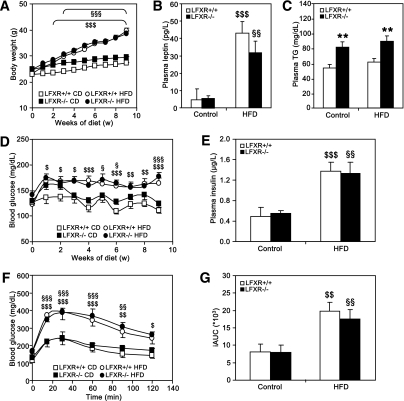FIG. 6.
Liver-specific FXR deficiency does not protect from diet-induced obesity and insulin resistance. LFXR−/− mice and LFXR+/+ littermates (n = 7–12/group) were fed a HFD or a control diet (CD) for 10 weeks (LFXR+/+, white bars and symbols; LFXR−/−, black bars and symbols). A: Body weight was monitored weekly. Significance of the effect of diet (P < 0.0001) and age (P < 0.0001) as well as their interaction (P < 0.0001) was calculated by two-way ANOVA. Plasma leptin (B) and plasma triglyceride (TG) (C) were determined at the end of the feeding period. D: Fasting blood glucose was measured weekly. Significance of the overall effect of diet (P < 0.0001) and age (P < 0.0001) as well as their interaction (P = 0.0217) was calculated by two-way ANOVA. E: Plasma insulin was measured after 6 weeks of feeding. Blood glucose excursion (F) and integrated AUC (G) after administration of an intraperitoneal glucose bolus (1 g/kg glucose) were measured after 5 weeks of feeding (n = 6/group). Values are means ± SEM. Differences between diet groups over time were analyzed by two-way ANOVA and Bonferroni post hoc test; differences between genotypes or diet groups were calculated by Mann-Whitney test. *Compares genotypes of the same diet group; $compares diet groups for LFXR+/+; §compares diet groups for LFXR−/− ($ or §P < 0.05; **, $$, or §§P < 0.01; $$$ or §§§P < 0.001).

